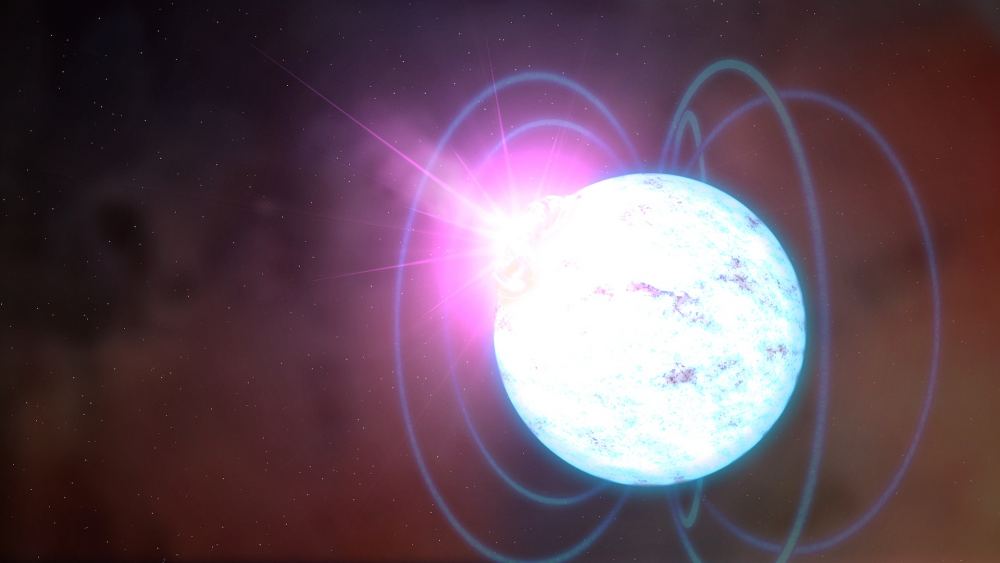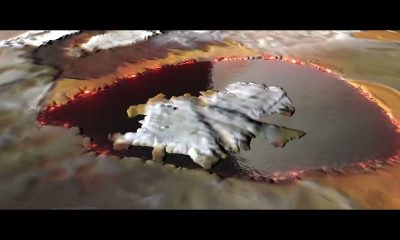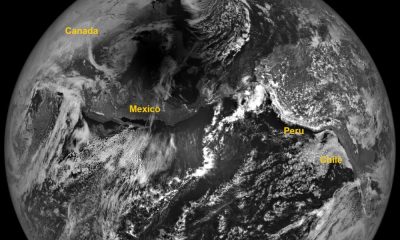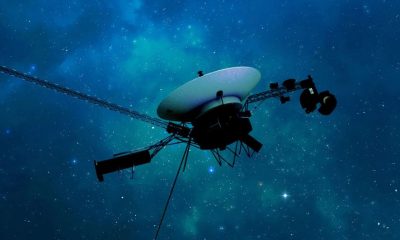News
Neutron Stars Can Have a Maximum Mass of 2.25 Solar Masses

When stars grow old and die, their mass determines their ultimate fate. Many supermassive stars have futures as neutron stars. But, the question is, how massive can their neutron stars get? That’s one that Professor Fan Yizhong and his team at Purple Mountain Observatory in China set out to answer.
It turns out that a non-rotating neutron star can’t be much more than 2.25 solar masses. If it was more massive, it would face a much more dire fate: to become a black hole. To figure this out, the team at Purple Mountain looked into what’s called the Oppenheimer limit. That’s the critical gravitational mass (abbreviated MTOV) of a massive object. If a neutron star stays below that Oppenheimer limit, it will remain in that state. If it grows more massive, then it collapses into a black hole.

Understanding the Physics of a Neutron Star
So, why determine the upper mass of a neutron star? The Oppenheimer limit for these objects has some implications for both astrophysics and nuclear physics. Essentially, it indicates that compact objects with masses greater than 2.25 solar masses are probably what scientists term the “lightest” black holes. Those objects would likely exist in a range of 2.5 to 3 solar masses.
The whole thing is rooted in the way that stars age. Everything depends on their starting mass. So, for example, our Sun is a lower-mass yellow dwarf and it will take more than 10 billion years to go through its whole life cycle. It’s about 4.5 billion years old now. As it ages, it will consume heavier elements in its core, which will heat it up. That drives expansion, which means the Sun will become a red giant and cast off its outer layers beginning in about five billion years. Eventually, it will shrink to become a white dwarf. That tiny object will contain less than the mass of the Sun, although some white dwarfs can be slightly more massive.
How a Neutron Star Forms
Stars much more massive than the Sun go through the same cycle, but they end their lives in supernova explosions. What’s left becomes a black hole. Or, if there’s not quite enough mass left after the explosion, the remnant becomes a neutron star. So, that means there’s a delicate line between it and a black hole. That line is the Oppenheimer limit.

Stars between 8 and 25 solar masses produce neutron stars. Something called “neutron degeneracy pressure” holds those odd remnants together. The leftover core of the star compresses after the supernova explosion. But, neutrons and protons in atomic nuclei in the core get pushed tightly together and they can’t be compressed any more. So, the system goes into a weird equilibrium. At that point, the resulting neutron star is approaching the Oppenheimer limit. If the object gains (or has) any more mass, that puts it over the limit. The result is a black hole.
Refining the Oppenheimer Limit for Neutron Stars
Professor Fan’s team worked to find a more precise value for the Oppenheimer Limit. To do this, they gathered data from such observations as those made by the Laser Interferometer Gravitational-Wave Observatory (LIGO) and the VIRGO gravitational wave detector, as well as an instrument aboard the International Space Station called The Neutron Star Interior Composition Explorer Mission (NICER). These and other missions detect the effects of neutron star collisions and neutron star-black hole encounters. NICER, in particular, studies the timing of x-ray emissions at neutron stars and works to answer the question: How big is a neutron star? By knowing the size and mass of neutron stars, astronomers can gain a further understanding of their formation and the exotic matter they contain.
The team incorporated information about the maximum mass cutoff (i.e. what’s the highest level of mass a neutron star can have) inferred from the distribution of these objects. They used models of the equation of state in their work. The equation of state basically looks at the state of matter in the neutron star (and black hole) and the models describe the parameters under which it exists (including pressure, volume, and temperature). The result of their work gives not only an upper bound to the mass of the neutron star (~2.5 solar masses) but also reveals that such a neutron star would have a radius of around 11.9 kilometers.
It’s interesting to see the precision in these measurements and models, based on actual data from multi-messenger observations of gravitational waves and soft X-ray emissions. Fan and the team suggest in the paper they published about their work that the objects with masses between 2.5 and 3 solar masses (detected by second-generation gravitational wave detectors) are most likely the lightest black holes.
Further Implications
The work also has some pretty interesting implications for cosmology, in particular the Hubble Constant. That’s the value assigned to the rate at which the Universe is expanding. It lies somewhere around 70 kilometers per second per megaparsec (plus or minus 2.2 km/sec/Mpc). The numbers depend on which methods astronomers use to calculate them.
The Fan team’s work suggests that the mass cutoff for neutron stars detected by gravitational waves should align with MTOV. That does not change with redshift. The Oppenheimer Limit mass cutoff is associated with both the redshifted mass of the object and its redshift. That’s predicted by the cosmological model and luminosity distance. This provides a new method to test the underlying cosmological model of the Universe. The current model begins with the Big Bang, inflation, and expansion. It also includes the distribution of all the matter (including dark and baryonic matter), and in corporates the contribution of dark energy.
For More Information
Maximum mass of non-rotating neutron star precisely inferred to be 2.25 solar masses
Maximum gravitational mass MTOV = 2.25 +0.08/-0.07 Ms inferred at about 3% precision with multimessenger data of neutron stars
ArXiv Preprint
News
Is now the right time to invest in gold as prices have cooled?

The price of gold has climbed to record highs recently and has remained strong through much of April. And, that growth continued until the precious metal traded at around $2,390 per ounce on April 19, 2024. But since, growth in the price of the precious metal has cooled, with gold’s price now hovering around $2,300 per ounce.
This lull in gold’s price may represent an investment opportunity.
In general, investing is centered around buying assets when prices are low and selling them when prices are high – generating a profit on the difference between the two. So, considering the declines in gold’s price over the past few days, now may be the time to make your investment. But is buying gold during this lull in prices really a good idea?
Compare your gold investment options among leading brokers now.
Gold prices have cooled. Should you buy in now?
With gold’s price down from recent highs, you may be wondering if now is the right time to buy in. There are several reasons the dip in gold’s price may represent an opportunity to buy. Here are some of the biggest:
Prices may rise again
If looking at a gold price chart shows anything for certain, it shows that changes in the overall growth of the medal come in fits and spurts. Periods of price growth are typically followed by periods of declines and vice versa.
But with inflation rising in recent months – and with gold’s reputation as a safe-haven asset that can hedge against inflation – it only makes sense that the price of the precious metal will eventually start to head up again in the future. While attempting to time that directional change may be tricky, buying the precious metal while the price is down gives you the opportunity to take advantage of any upward movement that may be ahead.
Add gold to your portfolio now before prices have a chance to rise.
You may be able to make a quick profit
Gold isn’t known as an asset in which you can earn a quick return, but in today’s market, that may be the case. Don’t forget that in January, gold was trading at just $2,000 per ounce. And, by mid-April, the commodity’s price had climbed to around $2,400 per ounce. That’s about 20% growth in a matter of months, much of which happened since March 1 – an impressive climb for any investment asset.
Perhaps more importantly, gold’s price growth through the beginning of 2024 shows that the commodity doesn’t have to be a buy and hold style investment that you keep in a safety deposit box or precious metal depository for years to come. There’s also the possibility that the commodity’s price could climb further ahead, making it a compelling way to potentially generate a quick profit.
There are other benefits of investing in gold
There are other benefits of investing in gold that have little to do with the price growth seen thus far in 2024 – or the lull in prices seen over the past couple of days. Those benefits include:
- Inflation protection: Gold has long been considered an inflation hedge, and for good reason. When inflation drives the prices of consumer goods and services up – and the value of the dollar down – gold’s price tends to rise. So, it could be used to maintain the value of your portfolio during inflationary economic conditions. That’s important in today’s economic environment as stubborn inflation continues to weigh on the value of the dollar.
- Portfolio diversification: Gold’s price doesn’t always move in the same pattern that bonds or stocks do. So, mixing a reasonable amount of gold into your portfolio (up to 10% of your portfolio assets) as a diversifier could protect you from losses should one or more of your traditional portfolio assets fall in value. “If you have less than 5% – 10% of your net worth in commodities & FX (forex), you should absolutely consider adding exposure to gold and other precious metals,” says Vijay Marolia, money manager and managing partner at the wealth management firm, Regal Point Capital.
The bottom line
Gold’s price has fallen from recent highs – which may represent an opportunity to tap into growth ahead. However, gold isn’t simply a “buy while it’s low and sell while it’s a high” kind of investment opportunity. The commodity can also protect your portfolio from the stubborn inflation we’ve seen thus far in 2024 while acting as a diversification tool that could increase your risk-adjusted portfolio returns. So, consider adding gold to your portfolio today while it has the potential to grow in value.
-

 News1 week ago
News1 week agoKevin McCarthy, former House Speaker, seeks revenge
-

 News1 week ago
News1 week agoJuno discovers massive lava lake on Io
-

 News2 weeks ago
News2 weeks agoKnowing the Magnetic Field of an Exoplanet’s Star is Essential to Determining the True Size of the Exoplanet
-

 News1 week ago
News1 week agoPossible Future Colleague of Trump: David Lammy, a Close Associate of Obama
-

 News2 weeks ago
News2 weeks agoAdditional Perspectives on the 2024 Eclipse: Views from the Moon and Earth’s Orbit
-

 News2 weeks ago
News2 weeks agoHouse speaker receives additional request from GOP member to resign or be ousted
-

 Entertainment1 week ago
Entertainment1 week agoBethenny Frankel reveals that her mother Bernadette Birk passed away from lung cancer
-

 News1 week ago
News1 week agoIs now the right time to invest in gold as prices have cooled?














